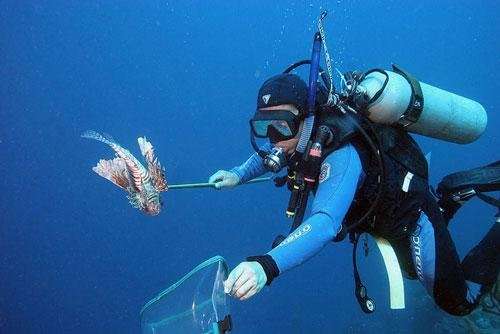Economists develop decision-making method for lionfish management

Lionfish are a prime example of damage caused by an invasive species brought into a new environment. With their venomous spines, aggressive behavior, and few natural enemies, these fish have the potential to harm reef ecosystems in the western Atlantic Ocean.
Natural resource managers need to plan and budget for activities to deal with an invasive animal like the lionfish. But until now there hasn't been a good method for figuring out how much to spend on gathering the information needed to effectively manage lionfish.
A team of economists led by Oregon State University developed a decision method that can be applied to the management of lionfish. Their method, they say, can be applied to other invasive populations, giving managers a tool for calculating the cost of not only eradication or mitigation, but also the monitoring that often needs to be done to keep management on track.
The study is published in the Journal of Environmental Economics and Management.
David Kling, an economist in OSU's College of Agricultural Sciences and lead author on the study, said the research shows that investing in monitoring an invasive population can pay for itself, chiefly by lowering the costs of management by making informed decisions.
The researchers used mathematical modeling to produce a decision-making framework that natural resource managers can use to properly account for the cost for targeted removal of lionfish from a priority area, such as a marine sanctuary.
"We're in a budget environment where ecological monitoring is often on the chopping block," Kling said. "It's sometimes been difficult for natural resource managers to quantify into dollars the cost of managing invasive species. We wanted to show the economic value of investing in information."
The research team relied on lionfish management documents and conversations with marine experts in developing its method.
The lionfish invasion in the Atlantic is believed to have begun in the 1980s. Lionfish have been reported along the southeastern United States coast from Florida to North Carolina. Juvenile lionfish have been collected in waters off Long Island, New York and Bermuda. The fish, native to the Pacific and Indian oceans and commonly found in home aquariums, have been shown to eat almost anything smaller than they are—fish, shrimp, crabs and octopus.
Governments, industry and conservation groups are trying to cull lionfish from their waters, and encourage their use as a food fish. Some removal efforts have concentrated on popular dive sites.
A 2014 study that included OSU showed that controlling lionfish populations in the western Atlantic can pave the way for recovery of native fish.
"The current management prescription is manually removing these fish; right now, there is usually no other way to keep their numbers low in sensitive marine habitats," Kling said. "Resource managers dealing with lionfish have to make hard budgetary tradeoffs, and accurate monitoring of lionfish is costly. We hope our model can ultimately be used as a support tool to help them make those decisions."
More information: David M. Kling et al. Optimal monitoring and control under state uncertainty: Application to lionfish management, Journal of Environmental Economics and Management (2017). DOI: 10.1016/j.jeem.2017.01.001
Stephanie J. Green et al. Linking removal targets to the ecological effects of invaders: a predictive model and field test, Ecological Applications (2013). DOI: 10.1890/13-0979.1
Journal information: Ecological Applications
Provided by Oregon State University


















